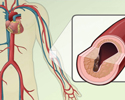Lipoprotein-a
Lp(a)
Lipoproteins are molecules made of proteins and fat. They carry cholesterol and similar substances through the blood.
A blood test can be done to measure a specific type of lipoprotein called lipoprotein-a, or Lp(a). A high level of Lp(a) is considered a risk factor for heart disease.
How the Test is Performed
A blood sample is needed.
How to Prepare for the Test
You will be asked not to eat anything for 12 hours before the test.
Do not smoke before the test.
How the Test will Feel
A needle is inserted to draw blood. You may feel slight pain, or only a prick or stinging sensation. Afterward, there may be some throbbing.
Why the Test is Performed
High levels of lipoproteins can increase the risk for heart disease. The test is done to check your risk for atherosclerosis, stroke, and heart attack.
It is not yet clear if this measurement leads to improved benefits for patients. Therefore, many insurance companies do not pay for it.
The American Heart Association and American College of Cardiology do not recommend the test for most adults who do not have symptoms. It may be useful for people at higher risk because of a strong family history of cardiovascular disease.
Normal Results
Normal values are below 30 mg/dL (milligrams per deciliter), or 1.7 mmol/L.
Note: Normal value ranges may vary slightly among different laboratories. Talk to your doctor about the meaning of your specific test results.
The example above shows the common measurements for results of these tests. Some laboratories use different measurements or may test different specimens.
What Abnormal Results Mean
Higher than normal values of Lp(a) are associated with a high risk for atherosclerosis, stroke, and heart attack.
Considerations
Lp(a) measurements may provide more detail about your risk for heart disease, but the added value of this test beyond a standard lipid panel is unknown.
References
Arnett DK, Blumenthal RS, Albert MA, et al. 2019 ACC/AHA guideline on the primary prevention of cardiovascular disease: A report of the American College of Cardiology/American Heart Association task force on clinical practice guidelines. Circulation. 2019;140(11):e596-e646. PMID: 30879355 pubmed.ncbi.nlm.nih.gov/30879355/.
Genest J, Mora S, Libby P. Lipoprotein disorders and cardiovascular disease. In: Libby P, Bonow RO, Mann DL, Tomaselli GF, Bhatt DL, Solomon SD, eds. Braunwald's Heart Disease: A Textbook of Cardiovascular Medicine. 12th ed. Philadelphia, PA: Elsevier; 2022:chap 27.
Libby P. The vascular biology of atherosclerosis. In: Libby P, Bonow RO, Mann DL, Tomaselli GF, Bhatt DL, Solomon SD, eds. Braunwald's Heart Disease: A Textbook of Cardiovascular Medicine. 12th ed. Philadelphia, PA: Elsevier; 2022:chap 24.
Meeusen JW, Ueda M, Nordestgaard BG, Remaley AT. Lipids and lipoproteins. In: Rifai N, Chiu RWK, Young I, Burnham C-A D, Wittwer CT, eds. Tietz Textbook of Laboratory Medicine. 7th ed. St Louis, MO: Elsevier; 2023:chap 36.
Robinson JG. Disorders of lipid metabolism. In: Goldman L, Cooney KA, eds. Goldman-Cecil Medicine. 27th ed. Philadelphia, PA: Elsevier; 2024:chap 190.
Review Date: 5/27/2024
Reviewed By: Michael A. Chen, MD, PhD, Associate Professor of Medicine, Division of Cardiology, Harborview Medical Center, University of Washington Medical School, Seattle, WA. Also reviewed by David C. Dugdale, MD, Medical Director, Brenda Conaway, Editorial Director, and the A.D.A.M. Editorial team.


